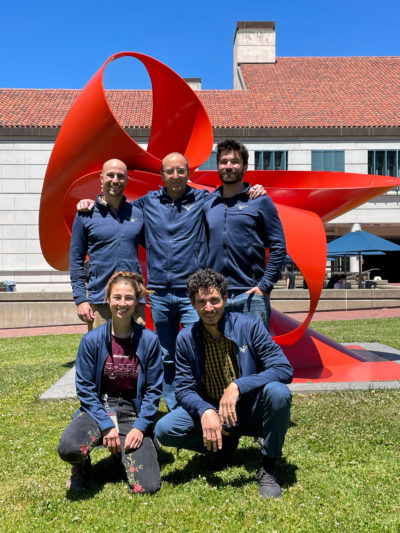 An Egyptian fruit bat takes flight. UC Berkeley researchers discovered that the GPS-like neural codes within bats’ brains remain unchanged over time, enabling the bats to remember — and navigate — familiar flight paths with high precision. (Photo by Yuval Barkai/@bats.tlv)
An Egyptian fruit bat takes flight. UC Berkeley researchers discovered that the GPS-like neural codes within bats’ brains remain unchanged over time, enabling the bats to remember — and navigate — familiar flight paths with high precision. (Photo by Yuval Barkai/@bats.tlv)Researchers resolve riddle of mammalian brain’s navigation system
Mammals navigate complex environments using a network of neurons that map out spaces and commit directions to memory. Now, UC Berkeley researchers have discovered that these GPS-like neural codes remain stable over time, a finding that upends previous research and may further our understanding of diseases like Alzheimer’s.
In a study published in Nature, a team of researchers in the lab of Michael Yartsev, professor of bioengineering and of neuroscience, studied neural activity in the hippocampus of freely flying bats and found that the neural codes remained unchanged over days and weeks.
“Leveraging the extreme precision of the bat’s flight and wireless imaging technology, we discovered that the neural code is actually very stable, in line with our stable memory of familiar environments, such as our home,” said Yartsev.

Authors of this study stand outside the NeuroBat Lab at UC Berkeley. Top row (left to right): Tobias Schmid, Michael Yartsev and William Liberti III; bottom row: Madeleine Snyder and Angelo Forli. (Photo by Yuka Minton)
In recent studies of these brain cells in laboratory mice, the positional codes within the hippocampus — a structure within the brain that has a major role in memory and navigation — had seemed to change their responsivity over time, even when nothing changed about the external environment.
These results puzzled the Berkeley researchers. “Presumably, we remember our home layout from day to day, so then why would the code in the brain be so unstable?” asked Yartsev.
To study this enigma, a diverse team of neuroscientists and engineers came together to examine the stability of these neural codes in bats, which are known for their exceptional spatial memory. They specifically selected Egyptian fruit bats for their ability to follow the same trajectories over hours and days with high precision, a critical component when studying positional codes.
Using novel wireless technology, the researchers recorded the neural responses in the bats’ brains over several weeks, as the bats flew highly structured paths in the NeuroBat Lab’s flight room. They discovered that the neural codes remained stable as the bats followed the same route during high-speed flight, from one day to the next.
“This finding was surprising because it suggests a simple explanation for why neural codes previously appeared to be unstable: unaccounted-for behavioral variability,” said Will Liberti, a postdoctoral researcher and the study’s first author with Tobias Schmid, a Ph.D. student in Yartsev’s lab. “Our results push back on a decade of research that had suggested tuning instability was a fundamental feature of the neural code.”
The results also highlight the value of using a comparative approach that examines the specialized behaviors of different species. “The widely held view — that the spatial code drifts over time — grew exclusively out of research in laboratory mice,” said Liberti. “We show that using the right animal model can help directly address longstanding questions in neuroscience.”
According to the researchers, understanding the stability of neural codes in the hippocampus may someday help us treat diseases, such as Alzheimer’s, that originate in this part of the brain. “If our stable neural codes get disrupted, then we lose our memories,” said Yartsev. “Our discoveries provide critical insight into the neural computations that are taking place in the hippocampus and could very well inform future therapeutic solutions.”
Understanding how neural codes are implemented and stored in the brain might also prove useful in the field of artificial intelligence. “Autonomous driving is a navigation problem, and the hippocampus is a neural circuit that plays a key role in navigation,” said Yartsev. “If we understand how the brain solves this problem, we can potentially reverse-engineer solutions that can be applied in engineering applications.”
